- Submissions

Full Text
Research & Development in Material Science
Design and Fabrication of an Instrument for Splitted Jute Fiber Length Measurement
Redwanul Islam1*, Hosne Ara Begum2, Sharif Ahmed3, Zakir Hossain HM4 and Fahmida-E-Karim5
1Lecturer, Department of Textile Engineering, Ahsanullah University of Science and Technology (AUST), Bangladesh
2Professor, Department of Yarn Engineering, Bangladesh University of Textiles (BUTEX), Bangladesh
3Assistant Professor, Department of Yarn Engineering, Bangladesh University of Textiles (BUTEX), Bangladesh
4Chief Scientific Officer, Bangladesh Jute Research Institute (BJRI), Bangladesh
5Lecturer, Department of Textile Engineering, BGMEA University of Fashion and Technology (BUFT), Bangladesh
*Corresponding author: Redwanul Islam, Lecturer, Department of Textile Engineering, Ahsanullah University of Science and Technology (AUST), Bangladesh
Submission: November 30, 2022;Published: December 15, 2022

ISSN: 2576-8840 Volume 18 Issue 2
Abstract
Fibers are the main raw materials in the textile industry. Now-a-days various types of fibers are available around the world but all fibers are not textile fibers. Because for being textile fibers, the fibers must have some particular physical and chemical properties. The length of natural fiber plays an important role both in the spinning process and product quality. In this work, it is highlighted about a long staple natural fiber which is called jute fiber. In the 19th century, jute fiber was called the *Golden Fiber* of Bangladesh. After that this fiber lost its name and fame for the cause of our negligence and lack of knowledge. It is very difficult to know about jute because a few people were working on it. Though it’s a long fiber but there are some problems with its fixed length because this fiber consists of a large number of ultimate cells whose length is 1.5 to 4 millimeters and these cells are attached by lignin which is known as natural cement. A long fiber which is 5 to 10 feet forms after attaching these ultimate cells. During the retting period some of the lignin layers break down and long fiber length of fibers becomes shorter. Another important thing is these fibers have a mesh structure for this reason it’s difficult to identify the actual length of the fibers. That’s why fibers obtained after retting are passed through jute carding machines. The main function of the jute carding machine is to split up and break down the mesh structure. After carding, it’s quite easy to measure the length of splitted jute fibers. There are not any suit-able machines for measuring the length of jute fibers. Previously people used the scale for measuring the jute fibers’ length manually, through this it is so difficult to measure the length of the long fibers accurately. Here an instrument has been designed with Arduino UNO, Ultrasonic distance sensor, Image-j software, C-programming and fabricated for measuring the fibers’ length easily and accurately as well as this instrument can measure the number of fibers in that particular length. By using this instrument anyone can easily measure the length of the fibers and the number of fibers within a short possible time efficiently.
Keywords: Splitted jute fiber; Arduino UNO; Ultrasonic distance sensor; Image-J software; C-Programming
Introduction
Jute is known as second most important fiber after cotton. It’s the hard and brittle fiber because of the presence of lignin layer. It’s come from nature that’s why it is environmentally friendly. The main chemical compositions are made of cellulose that’s why the product made of this can easily absorbed by the nature [1]. In the recent years the temperature of the environment is increasing because of the global warming. The reason behind this temperature rising is neglecting the environmental product. So that it’s necessary to replace the synthetic products with natural products. Jute fiber is a good source of natural cellulosic fiber [2]. At present the use of jute product is increasing day by day. In the past people was used jute for making sacks only. But now a day it’s changing. Many decorative products are making by using jute like carpet, mat, curtail etc [3].
The structure of jute fiber is brittle like because of the presence of the lignin layer. In general, it shows strong tensile properties with the presence of alkali [4]. Though is the strongest fiber that’s why the strength of this fiber depends on the structure of the cellulose. More oriented cellulosic structure shows more strength [5]. The strength of structure is needed to reduce for proper use. That’s why it is treated with chemical. Emulsion is one kind of solution which is used for making surface soften and that is useful to use for the nest process [6]. Actually there is no fixed length for jute fiber, but small length ultimate fibers are attached with each other and form a long fiber [7].
Materials and Methods
Materials
For this thesis work, it is tried to use those materials which are available around us. The material which has been used for the work are given below:
Arduino UNO, Breadboards, Jumping Wire, HC-SR04 ultrasonic range finder, Image-J software, Android mobile, USB cable, Glue gun, Anti-cutter, Toy wheel, PVC foam board, Comber.
Methods
Testing methods are very important thing for checking the
quality of any product. Types of testing methods:
a. Qualitative
b. Quantitative (a measured value)
c. Categorical [8]
Here quantitative testing method has been used.
The ultrasonic range finder distance measurement method: This sensor is post popular for using the distance accurately. The accuracy limit for measuring the distance of this sensor is 2cm up to 400cm. The working procedure of this sensor is same as the law of velocity. Here a frequency from the Vcc pin of the sensor emits and it’s reflected by any support and return to the sensor and this this frequency is captured by Echo pin. After that the distance can be measured by using the law of velocity.
The formula relating the speed of sound, distance, and time
travelled is:
Speed=Distance/Time
Rearranging this formula, we get the formula used to calculate
distance:
Distance=Speed ×Time
For getting the accurate result it is needed to maintain the air medium. Because the speed of frequency depends on the properties of the medium [9]:
C= 331.4 + (0.606×T) + (0.0124×H) (1)
C is Speed of sound (m/s)
331.4 is Speed of sound at 0 °C and 0% humidity
T is Temperature in °C
H is % Humidity
Fabrication of the instrument
Fabrication is the process of making something new with new dimension. Here it was fabricated a new designed machine for measuring the splitted jute fiber length. For fabrication of any electrical machine, it’s needed to make a complete circuit. The complete electric circuit has been given below (Figure 1):
Figure 1:Full circuit connection.

Designing the machine After making the circuit, now it’s time design the machine. After doing this the gets it proper shapes. Arduino Uno is using in the modern recent research work because it is easy for a new researcher who wants to work on automation system. This this many more modern basic programming code can be applied and by applying this one can invent new modern thing [10].
The main parts of this machine are i. Reflection board, ii. Side board, iii. Sensor carrier, iv. Device moving path. It was tried to make the design so simple as much as possible because this machine is designing at home by using the things near our hand. At first by using MS office the main frame design had been made. The design of the machine is given below (Figure 2).
Figure 2:Main frame of the machine.
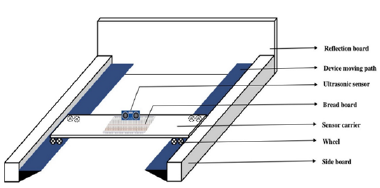
Making the parts of the machine by using materials for making the parts of the machine at first some PVC boards were taken and the materials by using anti-cutter with the following measurement (Table 1):
Table 1:Measurement of the major parts of the machine.

After cutting the parts, those were attached by using glue-gun. Then after few minutes it cool down and attached the pats strongly (Figure 3).
Figure 3:After attaching all parts.
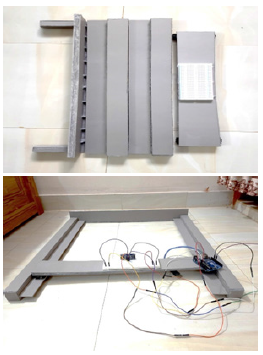
Installing the program at first C-programming was formed and checked that program by the using of Arduino software. The Arduino language is C++. The C++ language has become more popular for this Arduino [11]. By using this many hard and complex code can be solved easily [12].
After completing the connection the program is to be uploaded
on the Arduino.
#define trigPin 10
#define echoPin 13
void setup() {
Serial.begin (9600);
pinMode(trigPin, OUTPUT);
pinMode(echoPin, INPUT);
}
void loop() {
float duration, distance;
digitalWrite(trigPin, LOW);
delayMicroseconds(2);
digitalWrite(trigPin, HIGH);
delayMicroseconds(10);
digitalWrite(trigPin, LOW);
duration = pulseIn(echoPin, HIGH);
distance = (duration / 2) * 0.0344;
if (distance >= 400 || distance <= 2){
Serial.print(“Distance = “);
Serial.println(“Out of range”);
}
else {
Serial.print(“Distance = “);
Serial.print(distance);
Serial.println(“ cm”);
delay(2000);
}
delay(2000);
}
After uploading the code in Arduino the monitor looks like below (Figure 4):
Figure 4:The codes after verifying in arduino software..
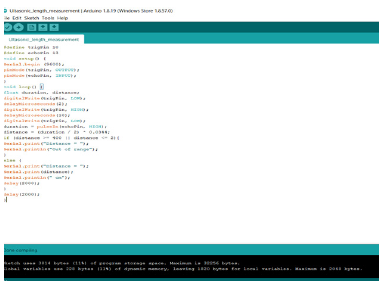
Results and Discussion
After the alignment of all splitted jute fibers from breaker card in Baer sorter diagram, we got various types length of jute fibers in diagram. Fiber sorter is an instrument which enables the sample to be fractionalized into length groups. The Baer sorter is the most popular method of the fiber sorter. Preparation of a fringe or tuft with all fibers aligned at one end. The separation or withdrawal of fibers in order of decreasing length. The preparation of a sorter diagram by laying the fibers on a black pad in decreasing order of length, the fibers parallel and their lower ends aligned along a horizontal base line as shown in Figure. Here it was trying to find out the accuracy of automated length measurement machine’s result as well as to compare the Baer diagram with the graph, which we got automatic way by using Image-J software.
Measuring the length and number of fibers of splitted jute
fibers in an automated way for Sample.
a) Identifying the length of the splitted jute fiber:
At first the Baer diagram of Sample is placed in the automated
machine. After doing this we marked the some length because those
lengths are needed to be measured. Then run the Arduino software
properly. If it runs accurately then the result will be shown in the
serial monitor. After taking the values from the serial monitor, the
values are plotted in an excel file (Figure 5).
Figure 5:Baer diagram of sample and identifying the length of splitted jute fiber in an automated way for a sample.

Table 2:Number of fibers in particular length for sample.
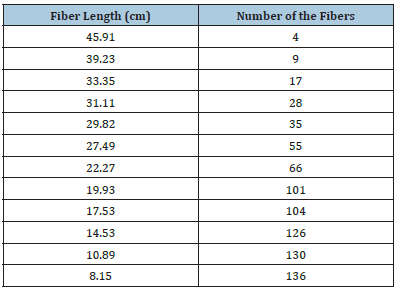
b) Counting the number of splitted jute fibers and plotting the diagram: At first captured the photo from the Baer diagram by using an android mobile and transfer the photo to the computer by using USB cable. Then we open Image-J software and analysis the number of fibers in that particular length, which is measured before by using an automated machine. After that the number of the fibers are calculated in that particular length and plotted those in an excel file and finally find a diagram which is generated automatically (Table 2).
These values should be plotted carefully for generating the actual graph (Figure 6).
The above graph shows different types of fibers lengths which have been identified from Sample-1. Here the maximum fibers length is 45.91cm and the minimum length of fibers is 8.51cm. Others length of fibers are situated between these maximum and minimum length of fibers. There are 136 of fibers in the given sample. It is easy to identify the number of fibers in particular length accurately.
Figure 6:Graph of number of fibers vs. fiber length for sample.
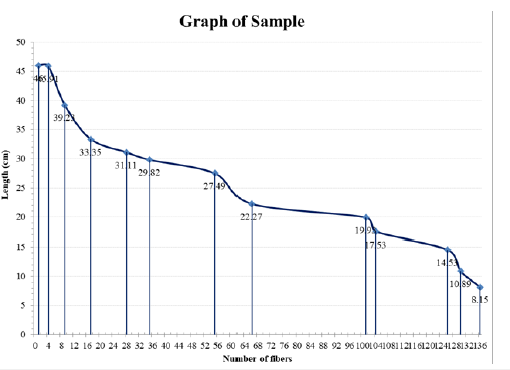
Limitations
This is known to all that there is no unmixed blessing on the
earth. So, like this it was very difficult to develop something new.
The reasons which were responsible for limitations are:
1. Shortage of jute related modern books and technologies.
2. Lacking of the development of jute machines.
3. Lacking of proper workshops.
4. Limitation of sensor related product for length
measurement.
5. Lacking knowledge of perfect programming for perfect
sensor.
6. Wasting a lot of time to gather knowledge about Arduino
Uno programming.
7. Had to study too many things like Arduino, c-programming
etc.
8. Limitations to go outside for gathering knowledge due to
COVID-19 pandemic situation.
Conclusion
Modern world is heading towards sustainable a product, that’s why a lot of scopes remaining to deal with the fibers which we get from nature. For this reason, it is needed to gather modern knowledge about these natural things. In this thesis work here, a modern machine has been fabricated. Through which the length of splitted jute fiber length can be measured easily as well as number of fibers can be identified. This is very important to know about the accurate length of fiber. There is no fixed length for jute fiber because of its mesh structure. That’s why it’s very difficult for the manufacturer to consider a particular length. If this is possible to measure the length, then many more products can be produced by using that particular length. Breaker carding machine is the first machine which breaks down the mesh structure. So it is very important to know about its initial breaking fiber length. By knowing this splitted fibers length next machine settings can be adjusted easily and perfect adjustment causes less breakage. As a result fine regular jute yarn can be produced with higher productivity. Diversified good quality jute products can be produced by using this quality yarn, which will impact our economical prospect by earning valuable foreign currency.
References
- Islam MM, Ali MS (2018) Industrial research advances of jute in Bangladesh. International Journal of Agricultural and Biosystems Engineering 3(1): 1-9.
- Feroz HM, Nahar J, Rahman M (2011) Eco-friendly jute processing in Bangladesh. Journal of Chemical Engineering 26: 70-4.
- Atkinson RR (1965) ATI Jute Fiber to Yarn (Book). BI Publocation, p. 11.
- Mwaikambo LY (2009) Tensile properties of alkalised jute fibres. Bio Resources 4(2): 566-588.
- Mwaikambo LY, Ansell MP (1999) The effect of chemical treatment on the properties of hemp, sisal, jute and kapok for composite reinforcement. Die angewandte makromolekulare Chemie 272(1): 108-116.
- Mukherjee A, Ganguly PK, Sur D (1993) Structural mechanics of jute: the effects of hemicellulose or lignin removal. Journal of the Textile Institute 84(3): 348-353.
- Fu SY, Lauke B (1996) Effects of fiber length and fiber orientation distributions on the tensile strength of short-fiber-reinforced polymers. Composites Science and Technology 56(10): 1179-1190.
- Form and Style for ASTM Standards - Technical Committees - Get Involved.
- Tsai WY, Chen HC, Liao TL (2005) An ultrasonic air temperature measurement system with self-correction function for humidity. Measurement science and technology 16(2): 548.
- Kumar P, Kumar P (2013) Arduino based wireless intrusion detection using IR sensor and GSM. International Journal of Computer Science and Mobile Computing 2(5): 417-424.
- https://www.softwareengineerinsider.com/programming-languages/cplusplus.html
- https://create.arduino.cc/projecthub/lina-tech-explorations/the-basics-of-arduino-programming-program-structure-functi-f5fb2c
© 2022 Redwanul Islam. This is an open access article distributed under the terms of the Creative Commons Attribution License , which permits unrestricted use, distribution, and build upon your work non-commercially.
 a Creative Commons Attribution 4.0 International License. Based on a work at www.crimsonpublishers.com.
Best viewed in
a Creative Commons Attribution 4.0 International License. Based on a work at www.crimsonpublishers.com.
Best viewed in 







.jpg)






























 Editorial Board Registrations
Editorial Board Registrations Submit your Article
Submit your Article Refer a Friend
Refer a Friend Advertise With Us
Advertise With Us
.jpg)






.jpg)














.bmp)
.jpg)
.png)
.jpg)










.jpg)






.png)

.png)



.png)






